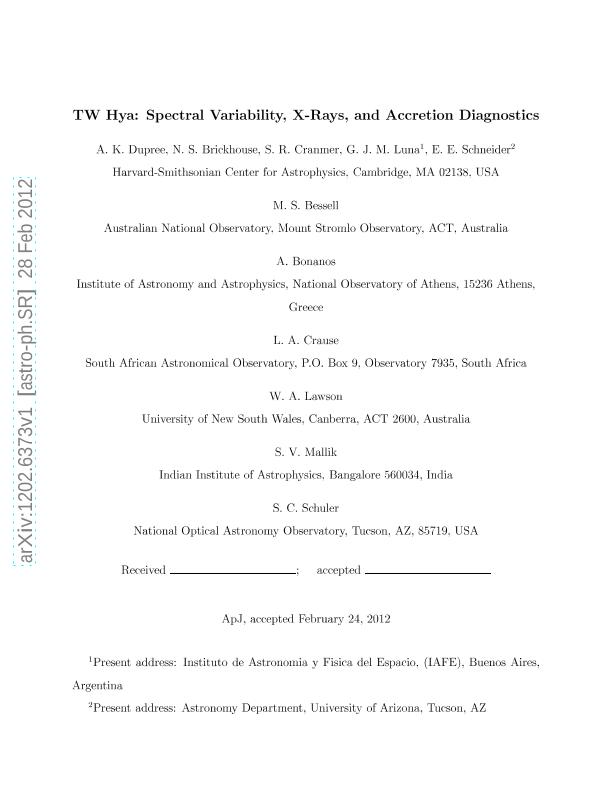Artículo
TW Hya: Spectral Variability, X-Rays, and Accretion Diagnostics
Dupree, A. K.; Brickhouse, N. S.; Cranmer, S. R.; Luna, Gerardo Juan Manuel ; Schneider, E. E.; Bessell, M. S.; Bonanos, A.; Crause, L. A.; Lawson, W. A.; Mallik, S. V.; Schuler, S. C.
; Schneider, E. E.; Bessell, M. S.; Bonanos, A.; Crause, L. A.; Lawson, W. A.; Mallik, S. V.; Schuler, S. C.
 ; Schneider, E. E.; Bessell, M. S.; Bonanos, A.; Crause, L. A.; Lawson, W. A.; Mallik, S. V.; Schuler, S. C.
; Schneider, E. E.; Bessell, M. S.; Bonanos, A.; Crause, L. A.; Lawson, W. A.; Mallik, S. V.; Schuler, S. C.
Fecha de publicación:
17/04/2012
Editorial:
Iop Publishing
Revista:
Astrophysical Journal
ISSN:
0004-637X
Idioma:
Inglés
Tipo de recurso:
Artículo publicado
Clasificación temática:
Resumen
The nearest accreting T Tauri star, TW Hya was intensively and continuously observed over ~17 days with spectroscopic and photometric measurements from four continents simultaneous with a long segmented exposure using the Chandra satellite. Contemporaneous optical photometry from WASP-S indicates a 4.74 day period was present during this time. The absence of a similar periodicity in the Hα flux and the total X-ray flux which are dominated by accretion processes and the stellar corona, respectively, points to a different source of photometric variations. The Hα emission line appears intrinsically broad and symmetric, and both the profile and its variability suggest an origin in the post-shock cooling region. An accretion event, signaled by soft X-rays, is traced spectroscopically for the first time through the optical emission line profiles. After the accretion event, downflowing turbulent material observed in the Hα and Hβ lines is followed by He I (λ5876) broadening near the photosphere. Optical veiling resulting from the heated photosphere increases with a delay of ~2 hr after the X-ray accretion event. The response of the stellar coronal emission to an increase in the veiling follows ~2.4 hr later, giving direct evidence that the stellar corona is heated in part by accretion. Subsequently, the stellar wind becomes re-established. We suggest a model that incorporates the dynamics of this sequential series of events: an accretion shock, a cooling downflow in a supersonically turbulent region, followed by photospheric and later, coronal heating. This model naturally explains the presence of broad optical and ultraviolet lines, and affects the mass accretion rates determined from emission line profiles.
Archivos asociados
Licencia
Identificadores
Colecciones
Articulos(IAFE)
Articulos de INST.DE ASTRONOMIA Y FISICA DEL ESPACIO(I)
Articulos de INST.DE ASTRONOMIA Y FISICA DEL ESPACIO(I)
Citación
Dupree, A. K.; Brickhouse, N. S.; Cranmer, S. R.; Luna, Gerardo Juan Manuel; Schneider, E. E.; et al.; TW Hya: Spectral Variability, X-Rays, and Accretion Diagnostics; Iop Publishing; Astrophysical Journal; 750; 1; 17-4-2012; 73-93
Compartir
Altmétricas



